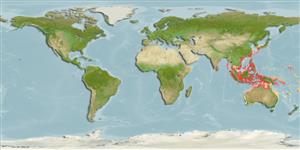Environment: milieu / climate zone / depth range / distribution range
Ecología
marino asociado a arrecife; rango de profundidad 20 - 40 m (Ref. 559). Tropical
Distribución
Países | Áreas FAO | Ecosistemas | Ocurrencias, apariciones | Point map | Introducciones | Faunafri
Western Pacific: southern Japan southward. Reported from the Indian Ocean (Ref. 45255). Randall & Pyle (2000, Ref. 48242) note that Pseudanthias manadensis has not been convincingly linked to any species recognized today.
Tamaño / Peso / Age
Maturity: Lm ? range ? - ? cm
Max length : 9.5 cm SL macho / no sexado; (Ref. 559)
Highly variable in color. Females have an orange to red spot on the back, centrally at the base of the spinous dorsal-fin, that elongates in larger individuals and males. In some males it shows as a yellow bar and some large individuals have extended tips on the caudal fin (Ref. 48635).
Inhabits rocky reefs. A deep water species, usually in depths over 40 m and appears to occur primarily on current-prone soft-bottom slopes (Ref. 48635).
Life cycle and mating behavior
Madurez | Reproducción | Puesta | Huevos | Fecundidad | Larva
Masuda, H., K. Amaoka, C. Araga, T. Uyeno and T. Yoshino, 1984. The fishes of the Japanese Archipelago. Vol. 1. Tokai University Press, Tokyo, Japan. 437 p. (text). (Ref. 559)
IUCN Red List Status (Ref. 130435: Version 2024-1)
Threat to humans
Harmless
Human uses
Herramientas
Special reports
Download XML
Fuentes de Internet
Estimates based on models
Preferred temperature (Ref.
123201): 24.2 - 28.5, mean 28 °C (based on 93 cells).
Phylogenetic diversity index (Ref.
82804): PD
50 = 0.5000 [Uniqueness, from 0.5 = low to 2.0 = high].
Bayesian length-weight: a=0.01349 (0.00618 - 0.02945), b=3.00 (2.81 - 3.19), in cm total length, based on LWR estimates for this (Sub)family-body shape (Ref.
93245).
Nivel trófico (Ref.
69278): 3.4 ±0.4 se; based on size and trophs of closest relatives
Resiliencia (Ref.
120179): Alto, población duplicada en un tiempo mínimo inferior a 15 meses (Preliminary K or Fecundity.).
Fishing Vulnerability (Ref.
59153): Low vulnerability (10 of 100).
